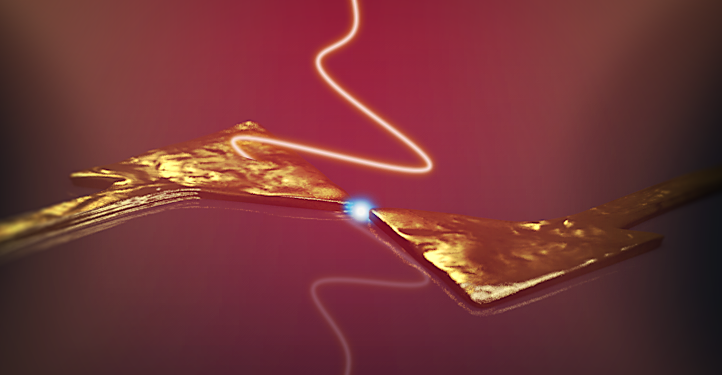Taming ultrafast electrons with light
The technological achievements in electronics have been absolutely impressive over the course of the last decades with a major impact to the society that has drastically evolved towards the digital age. The fundamental principle behind this revolution is quite simple: the capability to open and close an electrical circuit as fast as possible in order to perform operation on a sequence of bits. In fact, modern electronic transistors can operate at frequencies well beyond 1 GHz, corresponding to 1 billion operations per second. However, the standard technological platform for obtaining these results is based on semiconductors like Silicon and has reached a bottleneck with objective difficulties in improving the speed at which electronic components work.
To overcome this limitation, an international collaboration involving researchers of our group at the Center for Materials Physics (CFM-CSIC) and DIPC, in San Sebastian, at the University of Luxembourg, at the University of Konstanz (Germany), and at the CNRS-Université Paris Sud (France), exploited light to control the motion of electrons in a metallic nanocircuit. In fact, light has the advantage that it oscillates at frequencies that are a million times higher than the ones achieved by electronic circuits. For this reason, the control of a circuit at optical frequencies has the tremendous potential to revolutionize data processing and computing in the future.
While this goal is still far from being completely achieved, the experiments and theoretical development performed by the international team showed that it is possible to use the single electric field oscillation contained in a ultrashort laser pulse to drive electrons moving at sub-femtosecond time scales within a nanoscopic gap, creating a circuit that otherwise would be open. The work by the researchers traces the electrons motion at those ultrafast times driven by the taming photon pulse. The story published in the prestigious journal Nature Physics (https://www.nature.com/articles/s41567-019-0745-8), contains a detailed description of the experiments and the theoretical modeling devoted to understand how electrons move within this open gap between to metallic nanostructures.

The results of this work have a fundamental impact for the understanding on how light interacts with matter especially in a regime where it will be possible to observe quantum phenomena at temporal and spatial scales that were previously inaccessible. In addition, the impact of this research activity has also broader applications to nanotechnology, particularly in optoelectronics, since special nanodevices with high structural precision were fabricated to manipulate the electrons in the experiments, as well as in laser science, thanks to the development of novel laser sources able to deliver extremely short pulses at high repetition rate. Finally, the level of conceptual understanding and monitoring of the electron motion (dynamics) within the nanodevice will serve to exploit more complex non-linear operations in optoelectronic nanocircuits. These calculations have been developed in the group by Garikoitz Aguirregabiria, with the collaboration of Andrei Borissov at Orsay.
Tha paper can be found at:
Markus Ludwig, Garikoitz Aguirregabiria, Felix Ritzkowsky, Tobias Rybka, Dana Codruta Marinica, Javier Aizpurua, Andrei G. Borisov, Alfred Leitenstorfer and Daniele Brida. Sub-femtosecond electron transport in a nanoscale gap. Nature Physics. DOI: 10.1038/s41567-019-0745-8

